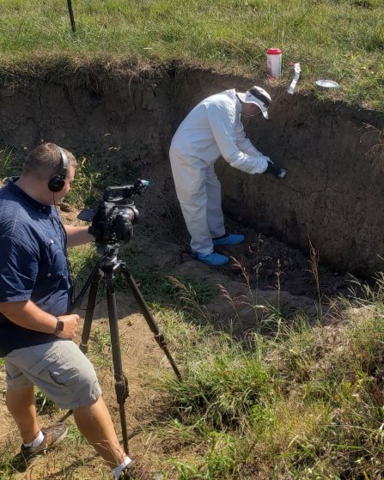
News
Forensic soil evidence collection training video now available
February 7, 2020 By Allison Getz
 Photo: University of Kentucky
Photo: University of Kentucky The Organization of Scientific Area Committees (OSAC) for Forensic Science’s Geological Materials Subcommittee, in collaboration with the University of Kentucky, the Federal Bureau of Investigation (FBI), and the IUGS-Initiative on Forensic Geology have developed a training video to help educate law enforcement and crime scene professionals on how to collect soil and other geological evidence.
Soil and other geological materials can prove to be valuable in criminal investigations and can help to link evidence to a suspect with similar soil on his or her shoes or clothing, from tools, or on a vehicle used in a crime.
The training video, produced in the fall of 2019, is intended to accompany a draft collection guide developed by OSAC’s Geological Methods Subcommittee. This guide, Standard Guide for Collection of Soils and Other Geological Evidence for Criminal Forensic Applications, describes the best practices for documenting, collecting, packaging, and preserving soil and other geological evidence items at crime scenes, alibi locations and reference locations. Read the guide here.
“OSAC documents typically have a targeted audience of forensic laboratory staff rather than field personnel. Therefore, we believed the collection guide needed to be translated to a format easily accessible to field personnel,” said Andrew Bowen, the chair of OSAC’s Geological Materials Subcommittee.
In the fall of 2016, the California Association of Criminalists (CAC) hosted a Soil Recognition and Collection Workshop where participants were provided with a draft of the collection guide and used it to conduct a practice exercise in the field. Workshop attendees expressed they gained a considerable amount of knowledge and reinforcement of the collection guide by participating in the hands-on field exercise. Feedback from the participants indicated the value of visual aids and in part inspired production of the training video.
“We expect this video to be a useful tool as a supplement to the collection guide. The value of the information we can provide is dependent on the quality of the samples we have to examine. Anything that improves the quality of samples is beneficial to the end product,” said Maureen Bottrell, FBI Geologist-Forensic Examiner.
The Collection of Forensic Soil Evidence Training Video is available on the University of Kentucky’s YouTube page at youtu.be/o9dWZOj1U5A, and can also be accessed, along with the draft collection guide, from the OSAC Geological Materials Subcommittee webpage.
This article originally appears on the NIST website here.
Allison Getz works in the special programs office at NIST, the National Institute of Standards and Technology, one of the oldest physical science laboratories in the U.S.
Print this page